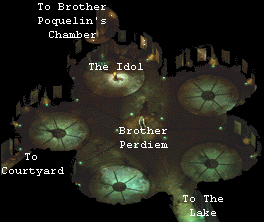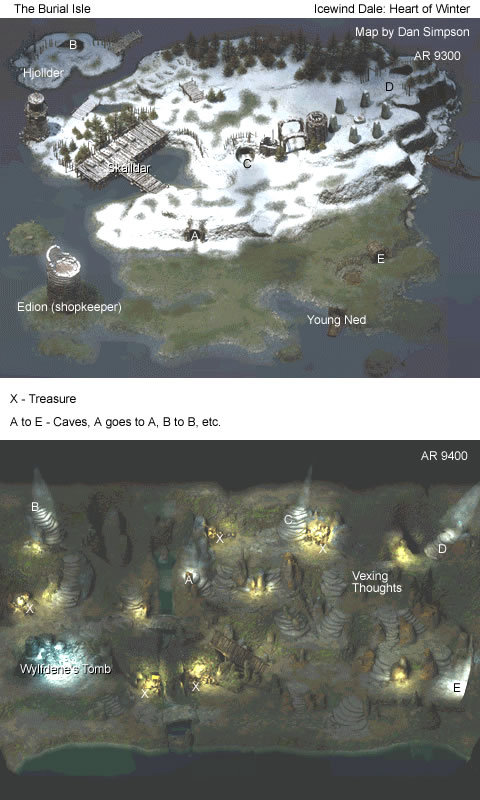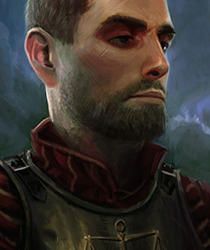#As those who have tried playing the original BG games or IWD 1 have likely learned
Explore tagged Tumblr posts
Text
There is a scale of tolerance in ttrpg players regarding how much maths and bookkeeping they'll do.
On one end is the player who copes best with the bare bones of the World of Darkness. As in basic mortals, vampires if you stretch. All they have to do, for the most part, is count dots. More maths than that causes distress.
On the other end is the maths nerd who wants you to port THAC0 into 5e rules and is in utter dismay that DnD is apparently decreasing the amount of numbers they need to juggle.
#Neither can be allowed near Mage the Ascension for very different reasons.#---#THAC0 existed purely to confuse the hell out of newcomers#As those who have tried playing the original BG games or IWD 1 have likely learned#babbling
9 notes
·
View notes
Text
Balance in Single-Player CRPGs
Someone on twitter asked me this question and I think it’s worth answering in a longer form than twitter allows. I’ve already answered this question in brief and in video form at various points, but I think it’s important to address here:
Something that bothered me from PoE was the constant updating to classes and races to balance them. Did you guys worry about this>
In Baldur's Gate I or II or even the Icewind Dale series? I mean really who cares if one class is OP or Race or Hybrid class? >>
You guys are making a single-player RPG not an MMO or game with a online multiplayer component.
Variants of this question are common in single-player CRPG circles. The implication is that balance is important in an MMO/multiplayer environment but it is not important (or so much less important that it doesn’t merit addressing in patches) in a single-player CRPG.
I would like to repudiate this in two general ways: 1) I will argue that overall balance is important and valuable for players in single-player CRPGs 2) I will argue that individual CRPG players and CRPG communities overall do not present consistent objections to tuning and this undermines the general complaint. It is not the responsibility of individuals or communities to be consistent in their feedback, but it is the job of the designer to design, which means considering the needs of the audience by listening to and interpreting feedback on a broader scale.
Yes, Balance is Important in Single-Player CRPGs
I think it’s easy enough to make the first point through reductio ad absurdum: why not give AD&D fighters 1d4 hit points per level, a worse THAC0 than wizards, and worse saving throws than any other class? Obviously it’s because playing them would feel terrible. Why don’t we give all of the enemies attacks that do 1-3 damage, a quarter of the hit points of the PCs, and rock-bottom defenses? Because playing through that would feel boring for anyone who had the slightest interest in combat content and systems.
Some may say, “Hey, no one is arguing that balance isn’t important at all,” but in fact that is what many people directly say or suggest. Maybe they don’t really mean it (which I will get to later), but that is often what comes up. If we can agree that some degree of balance is important, then there’s no point in suggesting anything to the contrary and we’re really just debating to what degree is balance important and worth a) design consideration pre-launch and b) patching.
In my view, balance in a single-player CRPG is important to the extent that it allows players making different character and gear choices to be viable through the content of the game. It is always important to remember that system design (including class, race, ability/spell, and item design) is one part of the equation. Content makes up the other big part (setting aside UI/UX for purposes of this discussion).
When our area and system designers build encounters, they have to be built around an understanding of party capabilities: their overall statistics, their available gear, their consumable items, and their various abilities. In a traditional D&D-style CRPG, this spectrum of possibility gets wider and wider the higher the levels get and the more gear becomes available to the player. The less balanced individual choices are from level to level and item to item, the more difficult it is for area designers to design content that works for a spectrum of choices.
It Was Actually a Problem in the Infinity Engine Games
One of the questions was, “Did you guys worry about this in... even the Icewind Dale series?” Well, no. I certainly didn’t worry about it in the original Icewind Dale. I assumed everyone who picked up the game was as conversant as me in AD&D 2nd Ed/Forgotten Realms rules and lore, had played hundreds of hours of it in tabletop with similarly aggressive psychogamers, and had weathered fair but diabolically brutal DMs whose scenarios demanded quick thinking and ruthless min-maxing tactics.
You might not believe the number of Black Isle QA testers (and developers) who yelled or cried in anger, virtually or in person, about how difficult some of the IWD scenarios were. One in particular was the Idol/priest fight in Lower Dorn’s Deep. I had a tester hootin’ and hollerin’ about how it was “impossible”, how he had tried to beat it for two hours and couldn’t make any progress. It was a scenario that I and my office mate (Kihan Pak) both beat on the first try.

On Heart of Winter, Burial Isle practically split QA in half. One half thought it was a cakewalk. The others acted like they were being forced to dive into a swimming pool full of razor blades.

The dividing factor was system mastery. AD&D 2nd Edition (and 3E) are systems with a boatload of trap choices, inherently bad builds, garbage spells/feats, and generally inferior options. They’re not presented as inferior options to the player. They’re presented as options... that turn out to be implicitly awful even in the best circumstances. To the next part of the question, “I mean really who cares if one class is OP or Race or Hybrid class?” The answer is, “The person being brutalized by content designed for the OP classes/races because they picked the ‘bad’ option.”
The broader that spectrum of choices is for players, the more difficult it is to design content that will be at a similar level of challenge for those players given any given combination of choices within that spectrum. And to restate what I wrote before, the balance is mostly important to the extent that viability, i.e., the ability to get through the content, is supported. BG, BG2, IWD, and IWD2 often failed that test. Once viability is addressed, I’m not particularly concerned about balance.
Tuning Down High-Powered Outliers
The exceptions are abilities and items that are so incredibly powerful across the board that it’s almost impossible to make any content challenging with them in play. If we design content to be challenging with those abilities/items in mind, any players who lack those abilities and items will effectively be crit path blocked. Their game has either ended or become so incredibly difficult that it’s no longer enjoyable. And if we don’t design content with the overpowered abilities and items in mind, any player who coincidentally or intentionally uses those items effectively no longer has any challenge going through the game. It becomes an unlabeled Easy difficulty slider rendering all other options/choices irrelevant.
In those cases, I advocate reducing the power of the abilities/items so players don’t trip over “Hey I guess I win” options and our testers can still use them in playthroughs and give meaningful feedback. There is one salient example I can think of: sniper rifles in Fallout: New Vegas. In Fallout 3, Bethesda had given sniper rifles a x5 crit rate modifier. Keep in mind that any attack from stealth (e.g. shooting an unaware target with a sniper rifle from long range) is automatically a crit. The x5 multiplier made even standard/close range combat shots have an incredibly high chance of critting. I didn’t notice that sniper rifles had that multiplier and it didn’t come up in testing prior to release. In release, players noticed it quickly and sniper rifles became the de facto way to handle most encounters. Why use a 12.7mm SMG or hunting pistol when any shot from a sniper rifle was likely to crit and do 90+ damage?

In one of the first patches, I reduced the crit rate multiplier to x2. There was initially a lot of complaining about it, as there always is when anything is tuned down, no matter how overpowered, but the sniper rifle retained its role and continues to be used in that role. It’s a sniper rifle. It’s good at sniping. It doesn’t need to be great at close range.
Inconsistent Player Feedback
There is one trend about player feedback regarding tuning that’s hard to argue against: communities generally complain about tuning anything down but applaud (or at least do not complain about) tuning things up. I can tune up 10 things in a patch and detune one thing and will hear far more feedback about the one thing that was detuned, no matter how marginal or necessary that detuning was. If there’s negative feedback about tuning something up, it’s usually because players feel it needs to be tuned up more.
In Patch 3.03 for Pillars of Eternity, Matt Sheets and I tuned up seven rogue abilities, five barbarian abilities, and a variety of other spells and abilities. Players generally seemed to like this, though some wished the rogue abilities had been tuned up more.
In Patch 3.04, the soulbound dagger The Unlabored Blade had a bug fixed where its 10% Firebug proc was never firing. Two weeks later, Patch 3.05 reduced the 10% proc to 3%. This was a change I had requested for 3.04 but it had been overlooked. I requested the change because daggers have a fast attack rate and that dagger has a +20% attack rate enchantment.

Which set of changes do you think I heard more feedback about? If you guessed the marginal drop in proc rate on the soulbound item that had only worked properly for two weeks, you’d be right. The rogue and barbarian changes affect far more players and more significantly, but “loss” (even if imagined for most players) weighs more heavily.
Despite having a reputation for only detuning, I tuned many more abilities and items up in PoE patches (and in F:NV patches, as well as the JSawyer mod) than down. Players remember the losses more than the gains, but both are a necessary part of the tuning process.
I could abstain from tuning, but I don’t think most players would benefit from that. Players remember early Diablo 3 tuning as particularly bad, but the game at launch (especially the economy and itemization) was poorly balanced, as Travis Day elaborated on in his 2017 GDC talk. In the long term, Diablo 3′s economy and itemization today are much better than they were at launch and I believe most players benefit from and appreciate that. Even if you effectively never played D3 as a multiplayer game, you still benefit from that.
I don’t expect players or communities to be consistent in their feedback, but as the director and, in many cases, the lone system designer, I have to make decisions on more than just the volume of feedback on any particular topic. Changes that make bad options better are almost universally good. Changes that make overpowered options worse are often still a good idea if I believe more players will benefit from the change. I didn’t hesitate to reduce the Petrified damage bonus from x4 to x2 in Pillars of Eternity because that affliction was far and away the best way to deal with difficult encounters, either through the Gaze of the Adragan spell or trap.
I Will Tune Again
Just to make this clear, while there will always be a point where I stop tuning a particular game, I’m never going to stop using patches as an opportunity to balance items, abilities, classes, encounters, enemies, etc. I’ve been house-ruling and tuning games since I noticed trap options and OP garbage in 2nd Edition AD&D in middle school. I re-wrote 5th Edition Ars Magica’s certamen system because it’s a cool idea that’s really uninteresting in play. I re-wrote Pathfinder/3.X’s armor system because, as many players have noted, it doesn’t actually provide many interesting options.
If I think players will benefit from adjusting the rules or the content and there’s an opportunity to make those changes, I’m going to do it. I certainly don’t expect players to like all of the changes I make, but if you object to the idea of post-launch balancing, you should probably never play any of the games I direct. I’m always going to tune them, if possible.
Thanks for reading.

Portrait by Jason Seow.
556 notes
·
View notes